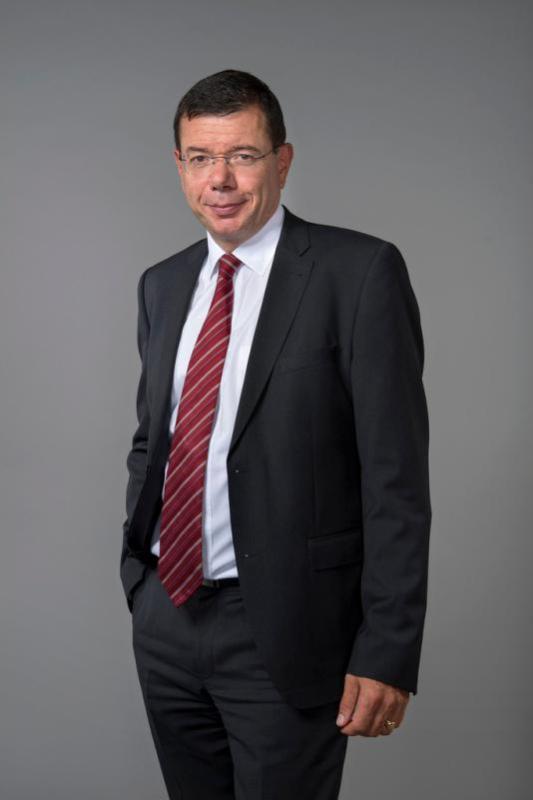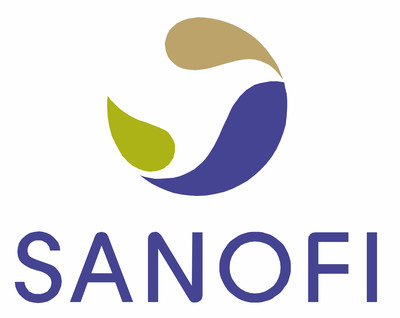Sanofi Q3 2019 well on track
PARIS, Oct. 31, 2019 /PRNewswire/ -- Sanofi (NASDAQ: SNY; EURONEXT: SAN)
|
Q3 2019 |
Change |
Change |
9M 2019 |
Change |
Change |
|
|
IFRS net sales reported |
€9,499m |
+1.1% |
-1.1% |
€26,518m |
+4.1% |
+2.2% |
|
IFRS net income reported |
€1,766m |
-22.3% |
- |
€2,816m |
-30.5%(2) |
- |
|
IFRS EPS reported |
€1.49 |
-18.6% |
- |
€2.33 |
-28.3%(2) |
- |
|
Business net income(1) |
€2,399m |
+4.3% |
+0.2% |
€5,805m |
+6.4% |
+4.1% |
|
Business EPS(1) |
€1.92 |
+4.3% |
0.0% |
€4.65 |
+6.4% |
+4.1% |
Experience the interactive Multichannel News Release here: https://www.multivu.com/players/English/8637251-sanofi-earnings-results-q3-2019/
|
Third-quarter 2019 sales performance(3) led by Sanofi Genzyme and Emerging Markets
Full-year business EPS guidance confirmed
Key R&D and regulatory milestones achieved
|
|
Sanofi Chief Executive Officer, Paul Hudson, commented: "Since joining Sanofi only two months ago, I am increasingly excited about the strength of our businesses, our ability to develop transformative medicines and the diverse talent of our teams across the organization. Building on this foundation, Sanofi delivered a resilient underlying performance in the third quarter with strong sales in Specialty Care, largely driven by the continued outstanding performance of Dupixent®. I am encouraged by the organization's early achievements in our efficiency initiatives, which will allow us to further drive innovation in our business. I'm looking forward to discussing Sanofi's strategic priorities at our Capital Markets Day in Cambridge, MA on December 10". |
|
(1) In order to facilitate an understanding of operational performance, Sanofi comments on the business net income statement. Business net income is a non-GAAP financial measure (see Appendix 8 for definitions). The consolidated income statement for Q3 2019 is provided in Appendix 3 and a reconciliation of reported IFRS net income to business net income is set forth in Appendix 4; (2) including in Q2 2019 a €1.8 billion impairment charge mainly related to Eloctate®; (3) Changes in net sales are expressed at constant exchange rates (CER) unless otherwise indicated (see Appendix 8); (4) Constant Structure: Adjusted for divestment of European generics business and sales of Bioverativ products to SOBI; (5) See definition page 9; (6) 2018 business EPS was €5.47. |
R&D update
Consult Appendix 6 for full overview of Sanofi's R&D pipeline
Regulatory update
Regulatory updates since July 29, 2019 include the following:
- In October, the European Commission approved Dupixent® (collaboration with Regeneron) as an add-on therapy with intranasal corticosteroids for the treatment of adults with severe chronic rhinosinusitis with nasal polyposis (CRSwNP) for whom therapy with systemic corticosteroids and/or surgery do not provide adequate disease control.
- In October, MenQuadfiTM, a meningococcal quadrivalent conjugate vaccine, was submitted in the European Union for the prevention of invasive meningococcal disease in individuals 12 months of age and older.
- In October, a quadrivalent recombinant influenza vaccine was submitted in the European Union for the prevention of influenza disease in persons 18 years of age and older (vaccine registered in the U.S. under the trade name Flublok®).
- In August, Dupixent® was approved by the European Commission for adolescents 12 to 17 years of age with moderate-to-severe atopic dermatitis who are candidates for systemic therapy.
At the end of October 2019, the R&D pipeline contained 85 projects, including 37 new molecular entities in clinical development (or that have been submitted to the regulatory authorities). 34 projects are in phase 3 or have been submitted to the regulatory authorities for approval.
Portfolio update
Phase 3:
- In September, the findings from the CARD study of Jevtana® (cabazitaxel) were presented at the 2019 European Society of Medical Oncology (ESMO) Congress. Data were also published in the New England Journal of Medicine and showed that patients with metastatic castration-resistant prostate cancer (mCRPC) previously treated with docetaxel and who progressed within 12 months on an androgen receptor targeted agent (abiraterone or enzalutamide) experienced significantly longer radiographic progression free survival (rPFS) with Jevtana® plus prednisone compared with abiraterone plus prednisone or enzalutamide. Overall survival (OS) with Jevtana® was also significantly longer.
- In August, positive topline phase 3 results for Dupixent® in children aged 6 to 11 years with severe atopic dermatitis were announced.
Phase 2
- In the third quarter, the NSCLC and Prostate Cancer combination cohorts with cemiplimab and isatuximab were discontinued due to efficacy considerations. This decision was not safety related. The ongoing combination trials in Multiple Myeloma and Lymphoma as well as combination trials with isatuximab and atezolizumab in solid tumors continue.
Phase 1:
- A phase 1 trial evaluating SAR442085, an anti-CD38 monoclonal antibody, was initiated in multiple myeloma.
- SAR443122, a RIPK1 inhibitor (collaboration with Denali) entered into phase 1.
- BIVV020, a complement C1s inhibitor, entered phase 1.
- The combination SAR442720 (SHP2 inhibitor) and cobimetinib entered phase 1.
- SAR441255, a trigonal GLP1R/GIPR/GCGR agonist was discontinued.
Collaboration
In September, Sanofi and Abbott announced a partnership to integrate glucose sensing and insulin delivery technologies that would help to further simplify how people with diabetes manage their condition.
Corporate Social Responsibility
Sanofi's commitment to good corporate citizenship is rooted in its heritage. The company recognizes that its core business creates value for society, and it works to ensure that the benefits of this societal value are accessible to as many people around the world as possible. The company also has a longstanding commitment to the communities where it operates and to minimizing its impact on the environment.
Sanofi's corporate social responsibility (CSR) approach was recognized during the third quarter of 2019 by the Dow Jones Sustainability Index (DJSI) for the 13th consecutive year. In 2019, Sanofi ranked as the third most sustainable pharmaceutical company with a score of 82 out of 100, up from 76 last year. The DJSI selects the best companies in each sector based on economic, social and environmental performance.
On October 15, 2019, Sanofi opened a digitally-enabled manufacturing facility in Framingham, one of the first of its kind, to develop transformative treatments for patients while significant reducing environmental waste. The facility will produce 80% less CO2 emissions compared to traditional technologies and reduce water and chemical usage by 91% and 94% respectively.
2019 third-quarter and first nine months financial results(10)
Business Net Income(10)
In the third quarter of 2019, Sanofi generated net sales of €9,499 million, an increase of 1.1% (down 1.1% at CER). First nine months sales were €26,518 million, up 4.1% on a reported basis (up 2.2% at CER).
Third-quarter other revenues increased 19.9% (up 14.8% at CER) to €422 million, reflecting the VaxServe sales contribution of non-Sanofi products (€372 million, up 18.7% at CER). First nine months other revenues increased 23.8% (up 17.2% at CER) to €1,096 million, driven by the VaxServe sales contribution of non-Sanofi products (€915 million, up 24.0% at CER) and the consolidation of collaboration revenues from Swedish Orphan Biovitrum AB (SOBI).
Third-quarter Gross Profit increased 0.9% to €6,787 million (down 1.8% at CER). The gross margin ratio decreased 0.2 percentage points to 71.4% (71.2% at CER) versus the third quarter of 2018. The favorable effects from Dupixent® and the divestment of the European generics business were more than offset by the negative impact from U.S. Diabetes net price evolution, the decline in Established Rx Products sales in Mature Markets as well as the impact of Vaccines and the Zantac® recall. In the third quarter of 2019, the gross margin ratio of segments were 74.8% for Pharmaceuticals (up 1.2 percentage points), 64.8% for CHC (down 2.0 percentage points) and 67.4% for Vaccines (down 2.7 percentage points). First nine months Gross Profit increased 5.1% to €19,095 million (up 2.8% at CER). In the first nine months of 2019, the gross margin ratio increased 0.7 percentage points to 72.0% (71.8% at CER) versus the same period of 2018. Sanofi expects its full-year 2019 gross margin ratio to be between 70% and 71% at CER.
Research and Development (R&D) expenses decreased 6.8% to €1,362 million in the third quarter of 2019. At CER, R&D expenses decreased 8.1%, reflecting favorable phasing of expenses, lower research costs resulting from restructuring of the immuno-oncology collaboration with Regeneron as well as a €45 million payment from SOBI related to the BIV001 opt-in. In the third quarter, the ratio of R&D to sales decreased 1.3 percentage points to 14.3% compared to the third quarter of 2018. First nine months R&D expenses increased 2.8% to €4,335 million (up 0.5% at CER). In the first nine months of 2019, the ratio of R&D to sales was 0.3 percentage points lower at 16.3% compared to the same period of 2018.
Third-quarter selling general and administrative expenses (SG&A) increased 0.6% to €2,314 million. At CER, SG&A expenses were down 1.5%, reflecting cost efficiency measures notably in Primary Care in Mature Markets and support functions as well as the impact of the European generics disposal which more than offset increased investments in Specialty Care. In the third quarter, the ratio of SG&A to sales decreased 0.1 percentage points to 24.4% compared to the third quarter of 2018. First nine months SG&A expenses increased 0.6% to €7,156 million (down 1.4% at CER). In the first nine months of 2019, the ratio of SG&A to sales was 0.9 percentage points lower at 27.0% compared to the same period of 2018.
Third-quarter operating expenses were €3,676 million, a decrease of 2.3% and 4.1% at CER. Excluding the payment from SOBI and the disposal of European generics business, operating expenses decreased 1.9% at CER in the third quarter. First nine months operating expenses were €11,491 million, an increase of 1.5% and down 0.7% at CER.
Third-quarter other current operating income net of expenses was -€119 million versus -€74 million in the third quarter of 2018. This line includes the share of profit to Regeneron of the monoclonal antibodies Alliance, reimbursement of development costs by Regeneron and the reimbursement of commercialization-related expenses incurred by Regeneron. This line also includes the share of profit/loss related to the immuno-oncology Alliance. In the third quarter of 2019, a total of €23 million of capital gains on non-strategic CHC brand disposals was also recorded. First nine months other current operating income net of expenses was -€312 million versus €84 million in the same period of 2018.
The share of profits from associates was €132 million in the third quarter versus €153 million for the same period of 2018, mainly reflecting the share of profits in Regeneron. In the first nine months, the share of profits from associates was broadly stable at €301 million versus the same period of 2018.
In the third quarter, non-controlling interests were -€12 million versus -€26 million in the third quarter of 2018, reflecting the end of non-controlling interests related to the Alliance with Bristol-Myers Squibb on Plavix® and Avapro®. First nine months non-controlling interests were -€27 million versus -€84 million for the same period of 2018.
Third-quarter business operating income increased 3.1% to €3,112 million. At CER, business operating income decreased 0.9%. The ratio of business operating income to net sales increased 0.7 percentage points to 32.8% versus the third quarter of 2018. Over the period, the business operating income ratio of segments were 39.0% for Pharmaceuticals (up 3.4 percentage points), 32.0% for CHC (down 1.2 percentage points) and 50.0% for Vaccines (down 5.3 percentage points).
|
(10) See Appendix 3 for 2019 third-quarter consolidated income statement; see Appendix 8 for definitions of financial indicators, and Appendix 4 for reconciliation of IFRS net income reported to business net income. |
First nine months business operating income was €7,566 million, up 5.9% (up 3.7% at CER). In the first nine months of 2019, the ratio of business operating income to net sales increased 0.4 percentage points to 28.5%.
Net financial expenses were -€71 million in the third quarter versus -€106 million in the same period of 2018, reflecting lower cost of net debt. First nine months net financial expenses were -€201 million versus -€211 million in the same period of 2018.
Third-quarter and first nine months effective tax rate was stable at 22.0%. Sanofi is currently actively engaged with the Chinese Ministry of Finance to support and cooperate with a Pharmaceutical sector audit process underway.
Third-quarter business net income(10) increased 4.3% to €2,399 million and increased 0.2% at CER. The ratio of business net income to net sales increased 0.8 percentage points to 25.3% versus the third quarter of 2018. First nine months 2019 business net income(10) increased 6.4% to €5,805 million and increased 4.1% at CER. The ratio of business net income to net sales increased 0.5 percentage points to 21.9% versus the first nine months of 2018.
|
In the third quarter of 2019, business earnings per share(10) (EPS) increased 4.3% to €1.92 on a reported basis and was stable at CER. The average number of shares outstanding was 1,252.2 million versus 1,247.1 million in the third quarter of 2018. In the first nine months of 2019, business earnings per share(10) was €4.65, up 6.4% on a reported basis and up 4.1% at CER. The average number of shares outstanding was 1,248.9 million in the first nine months of 2019 versus 1,247.6 million in the first nine months of 2018. |
Reconciliation of IFRS net income reported to business net income (see Appendix 4)
In the first nine months of 2019, the IFRS net income was €2,816 million. The main items excluded from the business net income were:
- An amortization charge of €1,636 million related to fair value remeasurement on intangible assets of acquired companies (primarily Genzyme: €550 million, Bioverativ: €380 million, Boehringer Ingelheim CHC business: €184 million, Aventis: €153 million) and to acquired intangible assets (licenses/products: €80 million). An amortization charge of €520 million related to fair value remeasurement on intangible assets of acquired companies (primarily Genzyme: €182 million, Bioverativ: €108 million, Boehringer Ingelheim CHC business: €62 million, Aventis: €46 million) and to acquired intangible assets (licenses/products: €24 million) was recorded in the third quarter. These items have no cash impact on the Company.
- An impairment of intangible assets of €2,023 million (of which €1,835 million in the second quarter mainly related to Eloctate® and €183 million in the third quarter which included an impairment related to Zantac®).
- Restructuring costs and similar items of €904 million (of which €157 million in the third quarter) mainly related to streamlining initiatives in Japan, Europe and the U.S.
- An income of €242 million mainly reflecting a contingent price adjustment on the disposal of SP MSD.
- A net income of €260 million (of which a charge of €57 million in the third quarter) mainly related to litigation.
- A €1,279 million tax effect arising from the items listed above, mainly comprising €906 million of deferred taxes generated by amortization and impairments of intangible assets and €247 million associated with restructuring costs and similar items. The third quarter tax effect was €374 million, including €195 million of deferred taxes generated by amortization and impairments of intangible assets and €50 million associated with restructuring costs and similar items (see Appendix 4).
- An expense of €94 million net of tax (of which €41 million in the third quarter) related to restructuring costs of associates and joint ventures and expenses arising from the impact of acquisitions on associates and joint ventures.
|
(10) See Appendix 3 for 2019 Third-quarter consolidated income statement; see Appendix 8 for definitions of financial indicators, and Appendix 4 for reconciliation of IFRS net income reported to business net income. |
Capital Allocation
In the first nine months of 2019, net cash generated by operating activities increased 58.2% to €4,976 million after capital expenditures of €992 million and an increase in working capital of €1,365 million (which compared with an increase of €1,925 million over the first nine months of 2018). Over the period, the dividend paid by Sanofi was €3,834 million, restructuring costs and similar items cash-out was €917 million and acquisitions and partnerships net of disposals reflecting a net cash-in during the period were €525 million. As a consequence, net debt decreased from €17,628 million at December 31, 2018, to €16,910 million at September 30, 2019 (amount net of €8,606 million cash and cash equivalents).
To access the full press release of the 2019 Q3 results, please click here.
Forward-Looking Statements
This press release contains forward-looking statements as defined in the Private Securities Litigation Reform Act of 1995, as amended. Forward-looking statements are statements that are not historical facts. These statements include projections and estimates and their underlying assumptions, statements regarding plans, objectives, intentions and expectations with respect to future financial results, events, operations, services, product development and potential, and statements regarding future performance. Forward-looking statements are generally identified by the words "expects", "anticipates", "believes", "intends", "estimates", "plans" and similar expressions. Although Sanofi's management believes that the expectations reflected in such forward-looking statements are reasonable, investors are cautioned that forward-looking information and statements are subject to various risks and uncertainties, many of which are difficult to predict and generally beyond the control of Sanofi, that could cause actual results and developments to differ materially from those expressed in, or implied or projected by, the forward-looking information and statements. These risks and uncertainties include among other things, the uncertainties inherent in research and development, future clinical data and analysis, including post marketing, decisions by regulatory authorities, such as the FDA or the EMA, regarding whether and when to approve any drug, device or biological application that may be filed for any such product candidates as well as their decisions regarding labelling and other matters that could affect the availability or commercial potential of such product candidates, the absence of guarantee that the product candidates if approved will be commercially successful, the future approval and commercial success of therapeutic alternatives, Sanofi's ability to benefit from external growth opportunities, to complete related transactions and/or obtain regulatory clearances, risks associated with intellectual property and any related pending or future litigation and the ultimate outcome of such litigation, trends in exchange rates and prevailing interest rates, volatile economic conditions, the impact of cost containment initiatives and subsequent changes thereto, the average number of shares outstanding as well as those discussed or identified in the public filings with the SEC and the AMF made by Sanofi, including those listed under "Risk Factors" and "Cautionary Statement Regarding Forward-Looking Statements" in Sanofi's annual report on Form 20-F for the year ended December 31, 2018. Other than as required by applicable law, Sanofi does not undertake any obligation to update or revise any forward-looking information or statements.
|
Media Relations: |
Investor Relations: |
|
Ashleigh Koss |
George Grofik |
|
908-981-8745 |
+33 (0)1 53 77 45 45 |
|
Email: Ashleigh.koss@sanofi.com |
Email: IR@sanofi.com |




![]() View original content:http://www.prnewswire.com/news-releases/sanofi-q3-well-on-track-300949042.html
View original content:http://www.prnewswire.com/news-releases/sanofi-q3-well-on-track-300949042.html
SOURCE Sanofi
Company Codes: NASDAQ-NMS:SNY, EuronextParis:SAN
